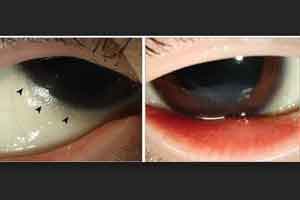- Home
- Editorial
- News
- Practice Guidelines
- Anesthesiology Guidelines
- Cancer Guidelines
- Cardiac Sciences Guidelines
- Critical Care Guidelines
- Dentistry Guidelines
- Dermatology Guidelines
- Diabetes and Endo Guidelines
- Diagnostics Guidelines
- ENT Guidelines
- Featured Practice Guidelines
- Gastroenterology Guidelines
- Geriatrics Guidelines
- Medicine Guidelines
- Nephrology Guidelines
- Neurosciences Guidelines
- Obs and Gynae Guidelines
- Ophthalmology Guidelines
- Orthopaedics Guidelines
- Paediatrics Guidelines
- Psychiatry Guidelines
- Pulmonology Guidelines
- Radiology Guidelines
- Surgery Guidelines
- Urology Guidelines
11 year boy on Strict Diet of Potato, Meat And Cereal goes Blind

An 11-year-old boy of East-Asian descent presented to the hospital with an 8-month history of progressive vision loss, night blindness, and light sensitivity. He also had a long-standing complaint of dry eyes. His medical history included diagnoses of eczema and multiple food allergies. Owing to concerns about food triggers of his eczema, the child had a restrictive diet consisting solely of potato, pork, lamb, apples, cucumber, and Cheerios. There was no history of redness, discharge, or trauma to the eyes. The vision loss was not associated with pain, headache, fever, or photopsias (flashes of light) according to the case report, published Oct. 2 in the journal JAMA Pediatrics.
When doctors examined the boy, they found his vision was severely impaired: He could see hand motions only when they were within 12 inches (30 centimeters) of his face. There was severe dryness of cornea with Bitot spots. The levels of vitamin A in the boy's blood showed a vitamin A deficiency. The boy's blood levels of vitamin A were 14.3 micrograms per deciliter (ug/dL) whereas the normal range for this vitamin is 25.8 to 48.7 ug/dL, according to the report.
For treating vitamin deficiency, the patient was given intravenous "megadoses" of vitamin A daily for two days, consisting of 200,000 IU, followed by a third dose 2 weeks later. (A normal dose of vitamin A for an 11-year-old boy is 2,000 IU daily, according to the Mayo Clinic.)
Vitamin A deficiency (VAD) or hypovitaminosis A is a lack of vitamin A in blood and tissues. It is common in poorer countries but rarely seen in more developed countries. Nyctalopia (night blindness) is one of the first signs of VAD. Clinical and subclinical VAD are problems in at least 75 countries. In 1994, the WHO classified countries as having clinical or subclinical, severe, moderate, or mild VAD. Clinical VAD (in which children demonstrate ophthalmic signs and symptoms, including blindness) occurs mainly in countries in Southeast Asia and sub-Saharan Africa. Severe VAD is also found in persons in refugee settlements and in displaced populations. An estimated 250 million children are at risk for vitamin deficiency syndromes. The most widely affected group includes up to 10 million malnourished children, who develop xerophthalmia and have an increased risk of complications and death from measles. Each year, 250,000-500,000 children become blind because of VAD.
For more details click on the link :
http://jamanetwork.com/journals/jamapediatrics/article-abstract/2654882

Disclaimer: This site is primarily intended for healthcare professionals. Any content/information on this website does not replace the advice of medical and/or health professionals and should not be construed as medical/diagnostic advice/endorsement or prescription. Use of this site is subject to our terms of use, privacy policy, advertisement policy. © 2020 Minerva Medical Treatment Pvt Ltd